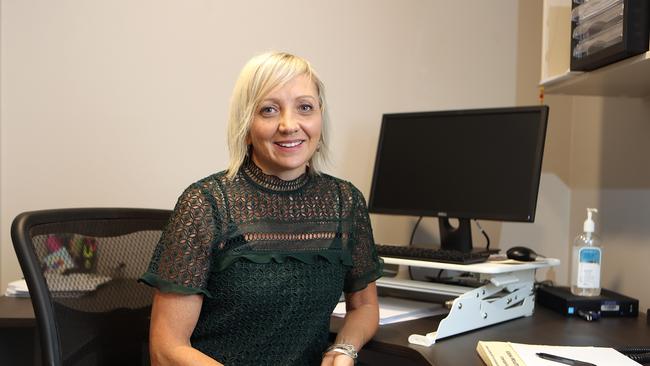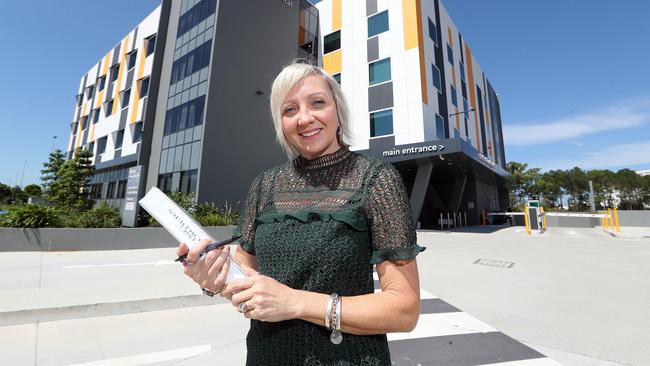THE age of 65 is a time for rewards.
Seniors can at last access a concession card, superannuation and a pension.
But for Margaret* it was the age she finally accessed help for an eating disorder.
While the age of Gold Coast children being treated for eating disorders spirals ever lower, with a significant spike in eight and nine year olds, the condition does not discriminate — even our senior citizens are among those seeking help.
Both men and women, boys and girls are among those affected, with eating disorders and disordered eating together estimated to affect one in six Australians, and that rate continues to rise.

It’s a true national crisis.
Dr Kim Hurst has been sounding the alarm for years.
The Robina Private Hospital senior psychologist specialises in eating disorders and is the president-elect of the Australia and New Zealand Academy for Eating Disorders.
THE INTERVIEW: DR LARA FARRELL
After years of lobbying for more funding to treat the illness, she is at last celebrating with the Federal Government announcing in this week’s Budget that six residential eating disorder centres will be established under a $70 million funding plan.
Added to that, from this November Australians with severe eating disorders will have access to a comprehensive treatment plan under Medicare for the first time, including up to 60 appointments with psychologists and dietitians.
It’s enough to give Dr Hurst hope — a welcome change when dealing with this disorder, where the death rate is higher than any other psychiatric illness.
In fact, she says over the past 10 years the Gold Coast landscape has been transformed when it comes to options for treating eating disorders, including binge eating disorders (BED), other specified feeding or eating disorders (OSFED), as well as anorexia nervosa and bulimia nervosa.
She says the city is now one of the leaders in the country when it comes to treatment, with Australia now a world leader itself.
OTHER NEWS:
Design of new $5m ‘central park’ revealed
‘Disgraceful’ incident at under 10s footy game
Five fun things to do on the Coast this weekend
Emaciated dog ‘two days away from death’
“Ten years ago we were crying out for treatment programs. There was so little help available both here and across the country,” she says.
“But now I’ve just come back from New York City where I was presenting on the massive developments that have happened here in this field.
“Australia is now at the forefront of making changes and the Gold Coast is one of the best places to come for treatment.

“I’m incredibly proud of what we do at Robina Private Hospital but it’s not just us; there are a range of service providers, including the public system, and it’s truly a team effort. That’s why we’re seeing success not only in the funding levels we’re achieving but in the prognosis for our patients.”
Dr Hurst has worked across a range of treatment settings, including psychiatric and medical inpatient units and outpatient services, but says the intensive eight-week day program offered at Robina Private has been a game-changer.
SUBSCRIBE TO THE BULLETIN FOR JUST $5 A MONTH FOR THE FIRST THREE MONTHS
She says the hospital is also now accepting referrals for its multi-family group therapy program (MFT), which aims to help and educate patients aged 14 to 19 as well as their families.
“Our intensive eating disorders program is one of very few in Australia,” she says.
“We’re coming up to its two-year anniversary and we’re preparing to publish a paper presenting the preliminary data we’ve recorded.
“Overall, we’ve seen great improvements in our patients. There has been a reduction in re-admission rates, increased weight gain for our anorexia patients, an increase in our patients’ ability to manage distressing emotions, a reduction in perfectionist tendencies. We’re seeing our patients re-engage with their lives.
“It can be a really challenging program for them, there are some distressing moments. Eating disorders are an incredibly difficult and crafty disease. But when you see that light bulb moment happen for a patient, when something clicks over and you can see them absorb and process that change, it’s so rewarding.”
Dr Hurst says the eight-week program accepts patients as young as 14 — with the oldest treated being age 65.
She says she sees even younger patients in one-on-one private sessions, with a number of eight and nine year olds being treated for avoidant and restricted food intake.
“The most common onset age for an eating disorder is puberty and that is happening earlier and earlier,” she says.
SUBSCRIBE TO THE BULLETIN FOR JUST $5 A MONTH FOR THE FIRST THREE MONTHS
“But we can’t forget that there are so many mature Australians who are suffering as well. Sometimes it is a case of late onset but sometimes they have had a severe and enduring illness which has spanned decades.
“It’s only in the last decade that we’ve really developed our treatment options here, but I think the Gold Coast has always been a hotspot for eating disorders. There is such a focus on body image and for so long it was a very transient population which meant not a lot of support.”
Dr Hurst says while the young age of some patients is alarming, parents should not be afraid to seek help.

She says the earlier the intervention, the better the outcome.
“We have a number of very young children who might present with some fussy eating and anxiety, that can then move into more extreme control issues like restricted eating, that can then get out of control and that’s when you see anorexia or bulimia,” she says.
“It’s very hard to predict. But any child with any kind of food-related anxiety issues, body issues, low self-esteem, perfectionist tendencies … get an assessment.
“Helping them now can literally save their lives. Many schools are doing a great job focusing on anti-bullying programs and resilience, some even have body image classes, but then we have others who do weigh-ins and focus on BMI (body mass index) figures, which can be extremely damaging.
“It’s never been easy to ‘grow up’, but it’s even harder now. There is an awful lot of pressure on young people to look a certain way and behave a certain way. Research shows that social media is making it worse, too. Couple that with low self worth or perfectionism and you need to be on the lookout for warning signs.”
Dr Hurst says there are various physical, psychological and behavioural warning signs that can signal the onset or the presence of an eating disorder.
She says that adolescent girls who diet at a severe level are 18 times more likely to develop an eating disorder within six months, while 70 per cent of adolescent girls have reported body dissatisfaction.
SUBSCRIBE TO THE BULLETIN FOR JUST $5 A MONTH FOR THE FIRST THREE MONTHS
However, she says the sufferer may make significant efforts to conceal their behaviour or they may not even recognise that there is anything wrong or that their eating habits have become “disordered’’.
“If there is a significant change in either weight increase or decrease, accompanied by behavioural changes around food, or attitudinal and mood changes, be alert.
“They might be experiencing anxiety around food or their body or putting themselves down over their appearance. If they are being bullied, be especially aware and actively discourage dieting — it’s a huge precursor to disordered eating.
“They might start making excuses about what, why and how they are eating, or become obsessive about food rituals, cutting food into tiny pieces, taking extra interest in food prep, or insist on ‘clean eating’.
“That whole fad about clean eating is such a concern. Anything extreme with food is unhealthy. It just provides the biggest smokescreen for what is really motivating them.
“As we say: it’s all about the food; it’s not about the food.”
Dr Hurst says for every one patient there is widespread collateral damage within the family too.
Many parents blame themselves.

“Despite all the warning signs, it’s actually very hard to catch this before it becomes a problem,” she says.
“Parents often blame themselves for not seeing it, or for modelling dieting behaviour, but they need to give themselves a break.
“This is an incredibly sneaky disease and it is so difficult for families, not just the stress and worry but needing time off to supervise their child, the cost of treatment and more.
“Now that we have some great treatment options for patients on the Gold Coast, I’d really love to set up a parent support group. They suffer a huge amount.”
Dr Hurst says while the prevalence of eating disorders continues to grow, it’s not all bad news.
She believes increased awareness accounts for the higher reporting.
“Look back 30 years ago, the death of (American singer) Karen Carpenter was really the first time that eating disorders became something we recognised,” she says.
“We still have a huge way to go, but we are making progress. I know a lot of people must think this is a tough job — and it can be — but I’m so passionate about what I do, I love it.
“We have better treatments, better research, better funding. There is hope.
“As sad as it is to see a 65-year-old woman come for help for the first time, isn’t it remarkable that she felt empowered to do so?
“I choose to see that as a sign of what we are getting right. If we can help her, we can help anyone.”
* Not her real name


OPINION: How GC can ‘maximise every opportunity’ ahead of 2032
The Gold Coast must capitalise on early investments in public transport, community venues, new tourism experiences, enhanced tertiary education and leading-edge technology, writes Tom Tate
‘Golden opportunity’: Why this is our most important two years
The Gold Coast faces its most important two years this century - and must extend light rail south of Burleigh and clarify its identity before the 2032 Games, a leading demographer says.